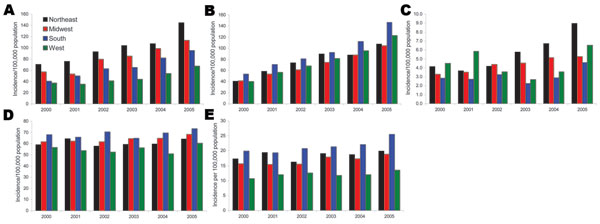Volume 14, Number 11—November 2008
Dispatch
Growth and Geographic Variation in Hospitalizations with Resistant Infections, United States, 2000–2005
Figure

Figure. Population incidence of component resistant infections in the United States, by census region, 2000–2005. A) Clostridium difficile–associated disease; B) methicillin-resistant Staphylococcus aureus; C) vancomycin-resistant enterococcus; D) Pseudomonas aeruginosa; E) Candida spp.
Page created: July 18, 2010
Page updated: July 18, 2010
Page reviewed: July 18, 2010
The conclusions, findings, and opinions expressed by authors contributing to this journal do not necessarily reflect the official position of the U.S. Department of Health and Human Services, the Public Health Service, the Centers for Disease Control and Prevention, or the authors' affiliated institutions. Use of trade names is for identification only and does not imply endorsement by any of the groups named above.